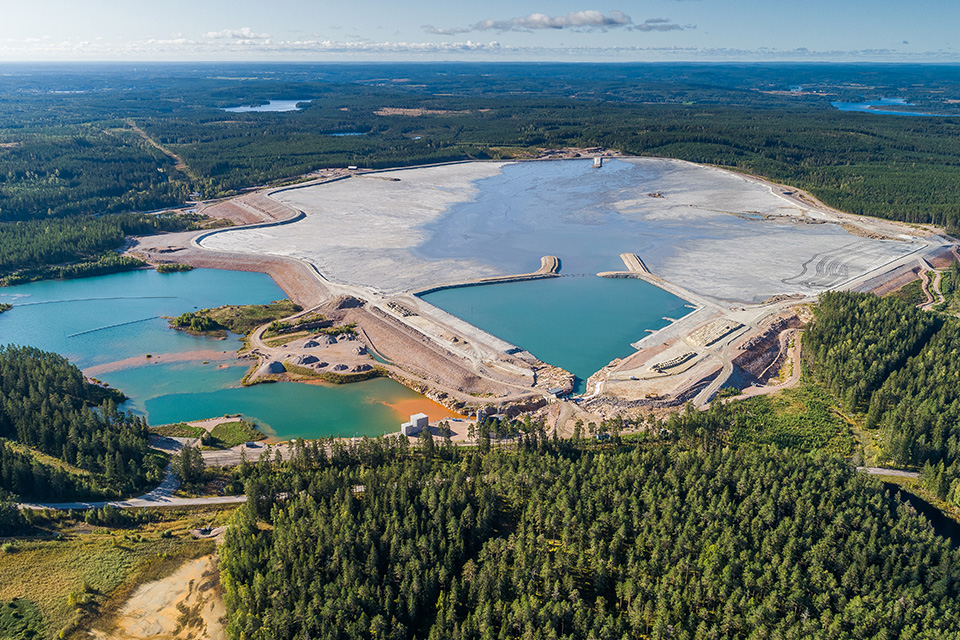Dam safety
In the role as national dam safety authority, Svenska kraftnät acts for a future with safe dams and coordinated preparedness for dam failures.
We contribute to national coordination and development through clear requirements, guidance and follow-up. We provide supervisory guidance to the county administration boards in matters of dam safety according to chapter 11 in the Environmental Code. We promote capacity building through research, development, education and information in collaboration with stakeholders. Each year, we follow up and report to the Government about dam safety developments.
Svenska kraftnät has the mandate from the Government to promote dam safety
Svenska kraftnät promotes dam safety through activities in the following areas:
We contribute to national coordination and development through clear requirements, guidance and follow-up. We have the mandate to issue regulation regarding the requirements in the Dam Safety Ordinance (2014:214).
We guide the county administrative boards in dam safety matters under Chapter 11 in the Environmental Code in order to achieve effective supervision. We provide advice and assistance to the county administrative boards in supervisory matters. We coordinate, follow up and evaluate the supervision on dam safety.
We follow the impact on dam safety related to climate change. We interact with the hydro power industry, the mining industry and the Swedish Meteorological and Hydrological Institute (SMHI) in the development work. Together we have issued guidelines for determination of design floods for dams.
We work to reduce the risk of serious impact to society caused by flooding or a dam failure in regulated rivers. We participate in the development and practice of coordinated emergency preparedness planning for dam failures in major regulated rivers.
We promote capacity building through research, development, education and information in collaboration with stakeholders. We support development projects in the dam safety program of the Swedish Energy Research Centre (Energiforsk). We also support the Swedish Centre for Sustainable Hydropower.
Together with stakeholders we spread information and experience on dam safety both nationally and internationally. We also participate in various networks and reference groups. In support of our function, we have a consultative body, the Dam Safety Council (Dammsäkerhetsrådet).
We participate in consultations and respond to submissions and referrals, inter alia, in permit application cases under Chapter 11 of the Environmental Code.

Dams in Sweden
In Sweden, there are an estimated 10,000 dams of varying size and age. Most of these dams are small and a dam failure with an uncontrolled release of water would generally have only minor consequences for the surrounding area.
There are around 2,000 dam facilities in the hydropower industry. Most large hydropower facilities in the country were built during the 1950s-1970s. After that, new construction in hydropower decreased, to almost cease during the 1990s.
In recent decades, instead, rebuilding and upgrading of existing dams with regard to aging and new safety requirements has been – and is – an extensive activity. Within the mining industry, the expansion of tailings dams continue, primarily through successive heightening of existing tailings dams.
The consequences of a dam failure can vary greatly, mainly depending on the amount of water impounded, the size of the dam and the conditions in the area that is flooded as a result of the failure.
Our book titled ” Book on Dams – The Swedish Experience (.pdf) Opens in a new window” tells the general story of Swedish dams from a historical and geographical perspective, supported by maps, pictures, and timelines. An annex presets a selection of around 40 dams that illustrate the development of dams in the country.
Dam safety framework
In Sweden several general statutes are applicable to dams and dam safety issues. The most important regulations are found in the Environmental Code and the Civil Protection Act.
According to the Environmental Code, the owner of a dam has the obligation to maintain the dam in order to avoid damage. The dam owner has strict liability and shall prepare and follow procedures for self-regulation.
The county administrative boards are responsible for dam safety supervision, i.e. supervision of the owners' self-regulation.
For further information about legislation and roles read "Dam Safety in Sweden" (.pdf) Opens in a new window.
In Sweden several general statutes are applicable to dams and dam safety issues. The most important regulations are found in the Environmental Code and the Civil Protection Act.
A new dam safety regulation came into force in 2014, in the form of amendments to the Environmental Code, the Dam Safety Ordinance (2014:214) and some additions to existing regulations. The regulation concerns dams where failure can have consequences of societal importance and/or present a risk to human life. It aims to prevent dam failures with serious consequences, by supporting development of the dam owners’ safety work and strengthening dam safety supervision.
The basis for the new requirements is the introduction of a classification system, based on the possible consequences of a dam failure, as the foundation for differentiated requirements of dam safety, self-regulation and supervision. The new requirements for classified dams and their owners include to establish and work in accordance with a safety management system, to conduct periodic in-depth dam safety reviews, to submit annual dam safety reports and to pay annual fees to the regional supervisory authority.
Currently about 450 dam facilities have a dam safety classification according to the Environmental Code. For these facilities a dam failure would result in significant consequences such as loss of human lives, serious environmental damages, damages to infrastructure or services vital to society and/or major economic damage. These dam facilities are spread all over the country. All in all, more than a hundred owners have classified dams. Most of the dams are within the hydropower industry.
The illustration shows parties, their main responsibilities and how they interact regarding dam safety.


Ongoing activities
We carry out assignments from the Government to further stimulate the development of dam safety. Some recent assignments are presented here.
Assignment regarding competence needs and coordination methods for effective dam safety supervision.
In 2022 Svenska kraftnät was given an assignment by the government to investigate competence needs and coordination methods for dam safety supervision. The assignment is to be reported in 2023. The aim with the assignment is to make the dam safety supervision more effective from a national perspective. Competence needs have never been clearly stated, making it difficult for the county administrative boards to plan their staffing for supervision and to follow up if the available competence is satisfactory. For counties with few classified dams, and thus small incomes from supervision fees, it is very difficult for the county administrations to build up satisfactory competence in-house.
Mechanisms for borrowing competence from other county administrative boards or even transfer the responsibility for the supervision to another county administrative board are in place, but have only been used to a very small extent. About ten larger dam owners have dams in more than one county. Methods for coordinated supervision of the dam owners’ dam safety management systems are to be investigated.
Dam failures are rare events that can have serious societal consequences. In Sweden development of emergency preparedness planning for high consequence dams in major hydropower rivers has been ongoing systematically since 2005, with an emphasis on regional collaboration. A general methodology for emergency preparedness planning has been applied successfully for more than 20 major and mid-size hydropower rivers over the years. A large number of concerned stakeholders have been involved in the projects.
In 2014 Svenska kraftnät, in its role as national dam safety authority, was given an assignment by the Government to identify needs and to prepare an action plan to further stimulate the development. The action plan included national collaboration and knowledge exchange, crisis management and learning from incidents and exercises, development of effective and reliable alarm routines, as well as development and implementation of routines to alert and inform the public. The action plan was implemented in 2015-2020 in collaboration with the hydropower industry, county administrative boards, rescue services and other involved stakeholders.
In 2020 Svenska kraftnät concluded that the action plan and the work in accordance with it had entailed a considerable development. Furthermore, a strong development has taken place regarding crisis management and dam safety, which has strengthened and contributed to the development.
Svenska kraftnät encouraged all stakeholders to maintain and if necessary further develop the planning, to use the guidelines and to participate actively in existing collaboration forums. Svenska kraftnät aims to further support the strengthening of the national capability for emergency management for dam failures and has in 2020 prepared a plan for the coming years, with an increased focus on activities to strengthen the local emergency planning. As a result of the implementation of the dam safety regulation the number of high consequence dams has increased and with that the number of target stakeholders.
Society's emissions of greenhouse gases and other human impacts have already affected the climate and further changes are expected. In Sweden the climate change influence seasonal weather patterns causing both gradual changes of mean values and changes in magnitude, frequencies, and timing of extreme weather events. From a dam safety point of view changes in heavy rainfall, snowmelt and extreme floods are in particular focus.
Changes have already been observed and are expected to continue within the technical lifetime of dam facilities, which will increasingly require adaptation measures. Furthermore, changes in reservoir operation and external factors due to climate change, such as the transition to a fossil free energy system, may also contribute to changes in safety margins.
In 1990 the first design flood guidelines were adopted. A nationwide reevaluation started and as a result the majority of Sweden’s large dams have been upgraded to be able to withstand and pass larger design floods than their original design. The Swedish guidelines for design flood determination have been updated to include the use of climate scenarios as well as to align with the 2014 dam safety regulation.
In 2022 Svenska kraftnät informed all owners of classified dams about the new edition of the design flood guidelines and performed a survey of the application of the guidelines. The purpose of the survey was to make a preliminary nationwide status assessment of to what extent the requirements in the design flood guidelines are met.
In 2022 the government assigned Svenska kraftnät to explore and analyse the impact of climate change on dam safety in cooperation with the power and mining industries, the Swedish Metrological and Hydrological Institute and other concerned authorities.

English translations of Swedish legislation and guidelines
In the following we have compiled a selection of legislation and guidelines relevant to dam safety. Please note that the translations are unofficial.